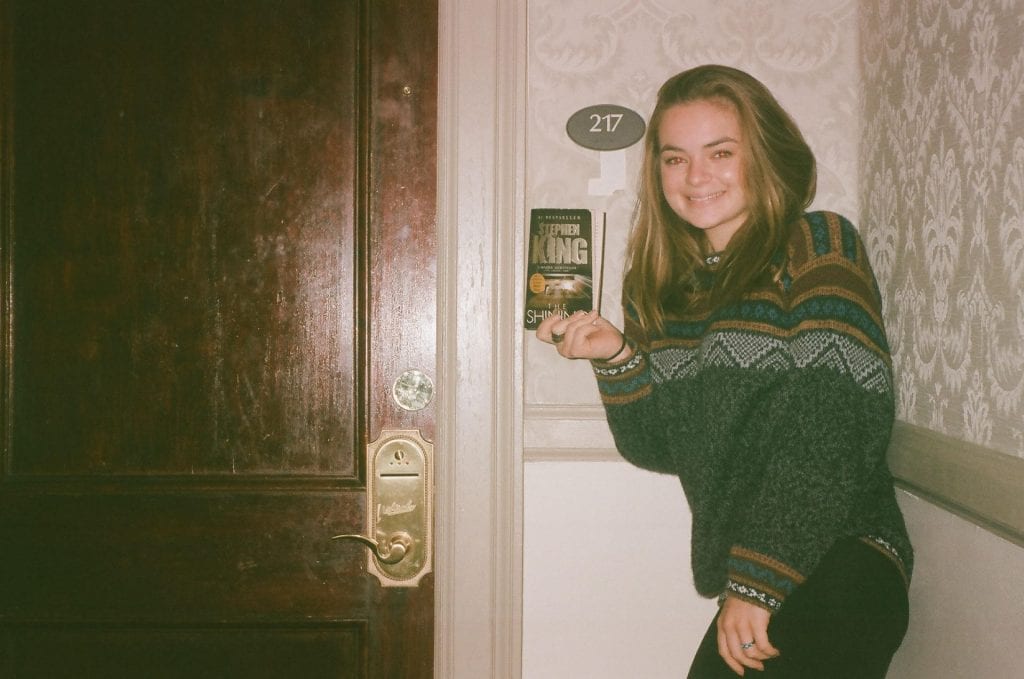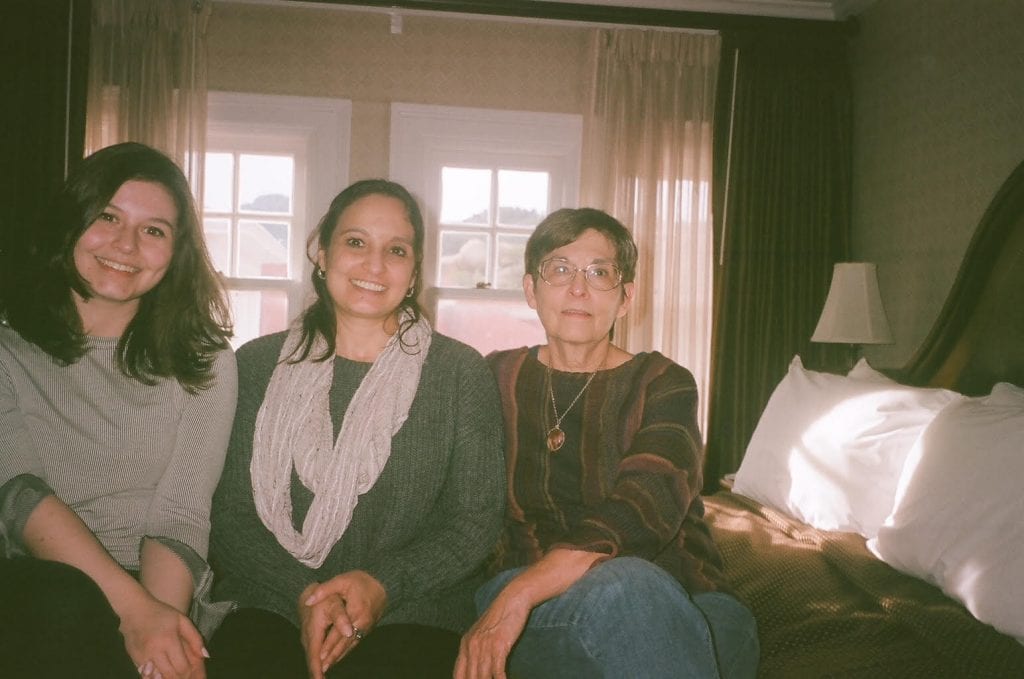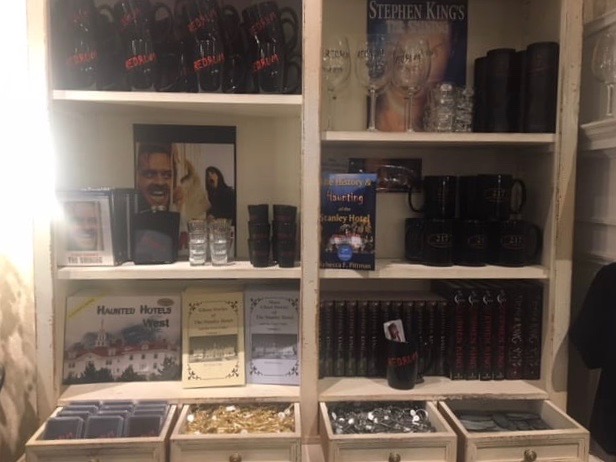Me on the Stanley's front lawn, reading The Shining.
“That’s the spookiest thing I’ve seen today,” Lauryn said, pointing to the $14 bowl of soup on the bar’s menu. Outside, it was snowing intermittently throughout the morning, so it was cold enough for most tourists to sit inside drinking the Stanley’s signature cocktail: Red Rum Punch, a mix of a variety of liquors, lime, pineapple, and agave (foods all native and signature to Colorado, a land-locked desert, of course). We had arrived at the Stanley a couple of hours prior after a two and a half hour drive (perhaps it would have been shorter if my car wasn’t from 1985 and could reach speeds above 54 mph).
The front of the Stanley Hotel, Estes Park.
Estes Park is entirely dependent on tourism—the town was settled and abandoned three times over because ranchers couldn’t survive the winters. What finally established the town as a viable place to live? It was, in fact, the Stanley Hotel. FO Stanley came to Estes Park in search of fresh mountain air to cure his tuberculosis, and when he fell in love with Rocky Mountain National Park’s scenery, he built a hotel to house his aristocratic friends who wanted to visit. Since 1907, people have been flocking to the Stanley to experience all that Colorado has to offer. Notably, the hotel was visited by the infamous Stephen King, a guest in 1974, who was so disturbed by his experience there that he wrote The Shining, a staple in the horror genre.
The novel follows the story of Jack, Wendy, and Danny, a family who has hit hard times. Jack is hired as the hotel’s caretaker for the winter—a very real position in the Stanley until the hotel installed a heating system in the early 1908s. The family moves in, but quickly, the story takes a turn as Jack begins to go insane and Danny, who has a special gift—“the shining”—is tormented by evil in the hotel.
A postcard from the gift shop of the Stanley Hotel in the early 1970s during winter time. It's truly isolated, in the heart of the Estes Valley--no wonder King felt like going crazy.
The disturbed nature of King’s story begs the question—how can John Denver’s “Rocky Mountain High” and The Shining be based on the same place? King, perhaps, captured the underbelly story of Colorado—on the surface, Colorado is beautiful, full of glorious mountains and wildflowers, a place “softer than a lullaby” where you can “talk to God.” Digging deeper, however, Colorado’s history is rather dark, riddled with corrupt mining companies, robber barons, characterized by greed and on some level, insanity. In pursuit of unravelling these questions, a friend, Lauryn, and I travelled to the Stanley to see what it’s actually about.
The morning started at the infamous Room 217, where Stephen King had stayed 44 years ago—the very room that inspired The Shining. In the novel, the hotel chef, Dick Halloran, who also “shines” like Danny, says “That’s where…a bad thing happened. I want you to promise me you won’t got in there, Danny. Not all winter. Steer right clear." The room has an 18-month long waiting list of other horror-fanatics eager to get the full haunted experience. Supposedly, the room is haunted by Elizabeth Wilson, a maid who worked at the Stanley for over 40 years.
Me standing in front of Room 217, like a true tourist. Spot any orbs? Also, notice the peeling wallpaper under the room badge from where guests had pulled it off the wall.
One night, a thunderstorm knocked out the Stanley’s power, so Mrs. Wilson was turning on oil lamps in each room. However, there was a gas leak in Room 217, and when she went to light the lamp, the entire room exploded. Surprisingly, she didn’t die in the explosion, but she still supposedly haunts the room to this day. Guests have reported blankets being pulled off of them, closet doors opening on their own, and perhaps most strangely, when unmarried couples stay in the room, they report the feeling of something nudging in between them. In the novel, no maid would clean Room 217 and no one from town would even go to the hotel. To add to the room’s fame, Jim Carrey stayed there while filming Dumb and Dumber. He requested the room, but not more than three hours into the night, he ran outside in his boxers and slippers screaming, begging to stay at a Holiday Inn. To this day, Carrey won’t answer any questions about what he experienced there.
Lauryn and I outside of the Stanley...waiting to be SPOOKED!
For us, however, Room 217 was the least creepy part of our adventure. Maybe Mrs. Wilson just wasn’t feeling us, or perhaps she was off cleaning another room. While we were taking pictures, a tour walked past, and the guide started by asking guests not to seal the placard with the room number on it—“They sell replications in the gift shop!”—which apparently happens multiple times per week. We continued to wander around. On the third floor, a maid left her cart in the hall, and we snagged a room key off of it to flash to hotel security if they asked what we were up to (guests floors were strictly off-limits to non-guests.
The fourth floor (said to be the most haunted floor in the hotel), was actually chilling. In the hotel’s hey-day, the fourth floor housed children and their nannies while their wealthy parents partied downstairs. One party, as described in the novel, had “men and women in costume, here a glittering princess, there a high-booted cavalier, flashing jewellery and flashing wit everywhere.” Guests have reported hearing laughing and footsteps running down the hall.
As Lauryn and I walked around, we both started having trouble breathing. When we passed Room 404, however, we instantly felt even worse. I got so dizzy I tripped into a wall, and Lauryn started coughing. When we walked further down the hall, we felt totally fine.
Lauryn outside of Room 404. Orbs?
Later in the day, we were reading The Shining on a bench near the main stairwell, underneath a bunch of portraits of the hotel’s former owners. I had gotten to a section in the novel describing the hotel’s history, and only upon sitting under the ever-creepy oil portraits did the accuracy of the novel shine through (pun intended). While talking to one of the hotel staff, we asked whether or not she read the novel, and said “I didn’t read it before working here, but it’s cool to read [now] and see how much research Stephen King actually did here and how much of the characters are actually real.” Each character King mentioned had a spot on the wall, a placard with their name on it. These names—which would be characters that later appear in the novel as demented, homicidal ghosts—made the novel all the more vivid and even creepier.
We read on. Numerous tours and wandering guests walked up and down the stairs.
“What are we? Room 404?” A grandmother asked her daughter. Lauryn and I immediately looked up from our books and at each other—
The family staying in Room 404.
“Excuse me,” I asked. “Are you staying in room 404?” They nodded.
“We just had the weirdest experience there,” Lauryn began explaining the dizziness, how heavy it was. The family was fascinated and started nodding along with us. They said they had stayed at the Stanley a couple of different times, but never on the fourth floor, so they specifically requested it.
“Well do you wanna go inside?” The grandmother asked. Their openness to share their room with us was striking—I certainly wouldn’t have let two people I had never met into my living quarters—but perhaps this speaks to some…Colorado hospitality: my haunting is your haunting, I guess. We followed the family up the three flights of stairs to the fourth floor. The daughter, like Lauryn, studied film. We ended up staying in the room for over an hour talking with the family about our own spooky stories.
They came to the Stanley every year around Halloween because they love the novel, they love the movie, they love ghost hunting, they love “this history.” To me, this appealed as a sort of pilgrimage—paying homage to our ghosty past.
“I was so excited to come here,” the mother said. “When we come here, I just run off like a kid in the candy store. It’s the coolest place here [Colorado].” She continued to talk about her nephew had a “gift.” This family, to me, captured something so quintessentially Colorado—how everyone has some experience, everyone is superstitious enough to sage their house and salt their doors…everyone has that Colorado “spook.” Stephanie, a tour guide off-duty, said: “I think the Stanley is one of the more authentic ghost experiences in Colorado, but it’s also the most touristy which really takes away from it…there are a lot of places in Colorado that are haunted, it’s just a haunted place.”
Rocky Mountain National Park, taken from the road leading to Estes Park, Summer 2018.
After taking a few photos, we left them to their haunted room and made our way outside. I’d been to Estes Park a hundred times—Rocky is a relatively near-by playground for four-wheeling junkies and mountaineers like my dad and I, and the road through Rocky ends in Estes. But every time, I’m taken aback—it is truly spectacular. The park is home to endangered buffalo, wolverines, and 32 mountain peaks higher than 13,000 feet—even King noticed this when he says “They were standing near the top of one people. Across from them, an even taller mountain reared in the sky." In fact, engraved on a statue of F.O. Stanley himself outside the hotel is a quote:
“Nature has endowed Estes Park in a wonderful manner. The grandeur of its scenery, its deep blue skies, its clear, cool, and invigorating air, its mountain streams of sparkling soft water, its sunny days and delightfully cool nights, are things the summer visitor never forgets, and having enjoyed once, desires to enjoy again.” (1928)
And yet, tourists will stay within the tiny campus of the Stanley Hotel, leaving only to visit McDonalds. After driving around for a bit, we settled on a small pull off on the road leading into the park—as far as we could get without getting yelled at by park rangers. As we sat and read, the weather went between sunny (so sunny, in fact, I got a sun burn) and snow—one extreme to another.
This terrain—the west—is characterized by such extremes. Annie Proulx, novelist and Wyoming-enthusiast, touches on the effect of such extremism in her story “The Blood Bay” from Close Range. She writes “A young Montana cowboy, somewhat vain, had skimped on coat and mittens… he crossed the Wyoming Territory thinking it would be warmer… the next afternoon, three cowpunchers from the Box Spring outlet near Suggs road past his corpse, blue as a whetstone and half-buried in snow” (93). Later, the story ends with a horse eating a cowboy’s corpse.
Proulx’s story hits on the ways in the harshness of the terrain of the west fundamentally distorts one’s humanity—to the point where a horse will eat a cowboy, or a father will try to kill his son. In fact, King’s Shining tells is so common to Colorado—man comes to mountains seeking a better life, man trapped by weather, man goes crazy. You can see it across the state—Alfred Packer, for example, brought a team of miners to Lake City, a tiny town at 8,600 feet in the middle of the mountains, looking for gold. However, by the end of the town’s brutally harsh winter, Packer ate his entire team—five fully grown men. Though grotesque, this story follows both King and Proulx in identifying how distorting these mountain winters are—a characteristic of Estes Park itself.
Rocky Mountain National Park from above--Lauryn took this during our descent to Denver International Airport.
Road to Animus Forks, Summer 2016.
King captures this quite precisely when Tony, Danny’s imaginary friend and prophet of-sorts, says “this inhumane place makes human monsters.” This winter-driven craziness identified by both King and Proulx is almost archetypal to Colorado itself. It is these extremes, in fact, that drove people out of Estes Park—famers couldn’t survive the winter—and this is true of so many other now-ghost towns in the state. Animus Forks, for example, was a mining town that was ultimately abandoned when winters became too extreme—there was even gold left to mine. Now, the place is so far off the beaten path, so inaccessible, that it is largely forgotten.
Young girl who was running around the "hedge maze" with her dad--the next generation of historians and ghost hunters, if you will.
What has kept Estes Park—a place with so much in common with Animus Forks, for example—from falling out of history, too? I think the answer to this is rather simple—The Shining. It’s true that the novel is based on the Stanley and tells some of the Stanley’s story, but more fundamentally, it has captured the American imagination in such a way that people are actually compelled to visit this tiny, cold, difficult place. People want to come to the Stanley and learn about its ghosts, its history. Outside the hotel, on the back of the same statue of FO Stanley is the quote:
"The legacy of FO Stanely in Estes Park is far larger and more enduring than any of the historic structures that bear his name. It is a legacy that extends to community and region and to the dreams of a remarkable man who through ingenuity, courage, and persistence, found a way to harness the emerging technological forces of the twentieth century to make those dreams a reality." [From James H. Pickering, Historian Laureate].
To locals, what was once a quaint hotel in the middle of Rocky Mountain National Park has quickly turned into the Disneyland of “wanna-be ghost hunters” and “horror fanatics.” Certainly irritating to some local shop owners, but even if the place is so commercialized now, perhaps that is a good thing—commercialization has preserved this place as relevant to contemporary American culture.
The Stanley is riddled with Shining memorabilia—you can order a Red Rum cocktail at the bar, take ghost tours, and the hotel even built a hedge maze out front for tourists to explore (the hedge was built in 2015 because tourists kept asking about the hedge maze in the movie).
Lauryn in the hotel's "hedge maze." It was installed in 2015, so it's rather...tiny. For reference, Lauryn is 5'2.
The hotel doesn’t even seem to promote the book-- most of the merchandise is for the movie, and the hotel even has a channel where it plays on repeat for 24 hours a day.
Even though the two tell completely different stories, that doesn’t seem to matter—people just have to know what the scariest book, the scariest movie in America is based on.
The gift shop wall dedicated to Shining memorabilia--almost a shrine! Prices: Redrum playing cards - $12, Gold, old-fashioned room key - $14 Silver, old-fashioned room key - $14 217 room badge - $15, Redrum mug - $15, The Shining, novel - $17 (mine from Amazon was $9), The Shining, DVD - $15, Redrum shot glass - $12, The Shining wine glass - $14, Coffee travel mug - $22
In their stay, however, they end up learning so much more—the ghost tour is actually quite historically informative—and they learn the history of Estes Park, of F.O. Stanley, and even the ghosts are historically archetypical figures to Colorado—robber barons, prostitutes, brothel owners, corrupt gangsters. Absent King’s novel, Estes Park likely would have had the same fate as so many other abandoned towns across the state—places that are also home to history and ghost stories, but weren’t lucky enough to house Stephen King for a night.
In this way, the novel functions as a sort of mechanism for preserving history. People make pilgrimages here for their family, people travel from all over to learn about the place that scared the hell out of Stephen King. Estes Park, then, is almost a stand-in for every other town that has since been abandoned. The exact stories are different, but the overarching theme of a people trying to build a life in a place so extreme is the same. People came to Estes Park, Ouray, Lake City, Silverton, Denver, even, to make it. Many failed, many succeeded, and both aspects of this story are captured in Estes Park.
There is something to be thankful for as a Coloradan, then, for a novel that has kept people curious about a history that has been so easy to lose.














